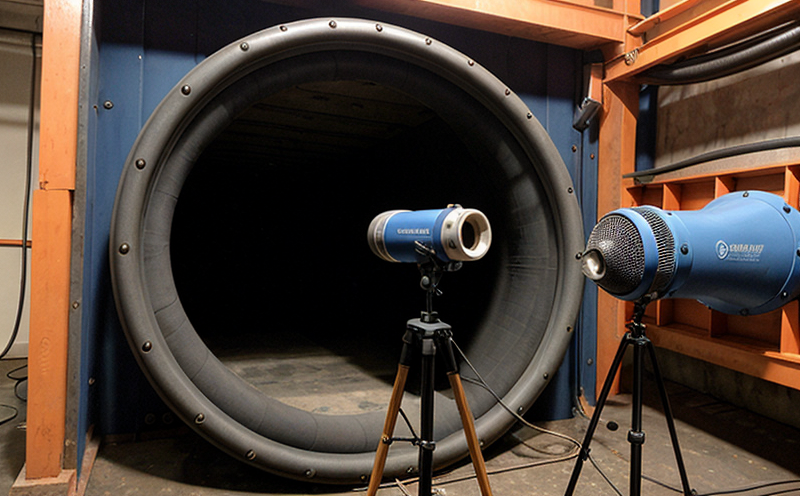ASTM E164 Ultrasonic Contact Examination of Weldments
The ASTM E164 standard provides a detailed method for performing ultrasonic contact examination on weldments. This non-destructive testing technique is widely used to assess the integrity and quality of welded joints in various industries, including aerospace, automotive, marine, and manufacturing sectors.
Ultrasonic testing (UT) is based on the principles of wave propagation through materials. When an ultrasonic pulse strikes a material, it can penetrate and reflect back from internal boundaries or defects within the material. In the context of ASTM E164, this method is specifically applied to examine welds for flaws such as porosity, cracks, incomplete penetration, and other imperfections that may affect structural integrity.
The technique involves placing a transducer in direct contact with the surface of the weldment. The transducer generates high-frequency sound waves that travel through the material until they encounter an interface or defect. These waves are then reflected back to the transducer, where their characteristics (amplitude and time-of-flight) are analyzed to determine the presence, location, and size of flaws.
The ASTM E164 standard specifies detailed procedures for setting up the test environment, selecting appropriate frequencies for the ultrasonic probe, calibrating the equipment, and interpreting the results. It also provides guidelines on specimen preparation, ensuring that the surface is clean and free from contaminants to achieve accurate measurements.
One of the key advantages of ASTM E164 is its ability to provide real-time feedback during the examination process. This allows for immediate assessment of weld quality, which can significantly reduce production time and costs associated with rework or scrapping defective components.
Another benefit of this method is its non-destructive nature, meaning that it does not alter the physical properties of the material being tested. This makes it particularly useful in industries where maintaining the integrity of critical components is essential.
The ASTM E164 standard also includes provisions for quantifying the size and location of defects detected during the examination. This information can be used to prioritize repairs or replacements, ensuring that resources are allocated efficiently.
Given its precision and reliability, ASTM E164 ultrasonic contact examination is a preferred method in industries where quality and safety standards are paramount. Its ability to detect even small flaws makes it an invaluable tool for ensuring the integrity of welded joints across various applications.
Why Choose This Test
- Non-Destructive Nature: ASTM E164 allows for testing without altering or damaging the material being examined, making it ideal for critical components where structural integrity is crucial.
- Precision and Reliability: The method provides accurate measurements of flaw size and location, ensuring consistent quality control across production runs.
- Real-Time Feedback: Immediate assessment capabilities reduce the time required for testing and subsequent actions, enhancing efficiency.
- Versatility: Suitable for a wide range of materials and weld types, making it adaptable to various industrial needs.
- Compliance with Standards: ASTM E164 ensures that testing meets international quality standards, providing confidence in the reliability of results.
- Cost-Effective: By identifying defects early in the production process, rework and scrapping costs are minimized.
Quality and Reliability Assurance
The ASTM E164 ultrasonic contact examination plays a critical role in ensuring the quality and reliability of welded joints across various industries. By adhering to this standard, manufacturers can demonstrate compliance with international quality standards, thereby enhancing their reputation and marketability.
One of the primary goals of this testing method is to identify and eliminate potential flaws that could compromise the structural integrity of weldments. This proactive approach helps in maintaining consistent product quality and reducing the risk of failures in critical applications.
The ASTM E164 standard provides a framework for conducting ultrasonic examinations that are both accurate and repeatable. This ensures that results can be consistently reproduced, providing confidence in the testing process. The detailed procedures outlined in the standard help to minimize human error and ensure that all tests are conducted under controlled conditions.
By incorporating ASTM E164 into their quality assurance processes, manufacturers can gain a competitive advantage by delivering products of superior quality. This not only enhances customer satisfaction but also helps in maintaining long-term relationships with clients.
Environmental and Sustainability Contributions
The ASTM E164 ultrasonic contact examination method contributes positively to environmental sustainability through its non-destructive nature and efficient use of resources. By ensuring that only high-quality materials are used, the testing process helps in reducing waste and minimizing the need for rework or scrapping.
Moreover, the precision and reliability of ASTM E164 allow for more accurate assessments of weld quality, which can lead to optimized production processes. This efficiency not only reduces energy consumption but also decreases material usage, contributing to a more sustainable manufacturing process.
The method's ability to detect even small flaws in welded joints helps in ensuring that only flawless components are used in critical applications. This minimizes the risk of failures and ensures that products meet the highest standards of reliability and safety. By promoting the use of high-quality materials, ASTM E164 supports a more sustainable approach to manufacturing.
Additionally, by reducing rework and scrapping, ASTM E164 helps in minimizing environmental impact associated with waste generation. This contributes to a greener production process, aligning with broader sustainability goals within the industry.





